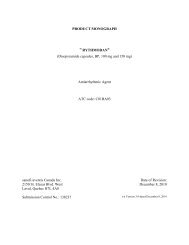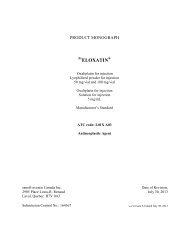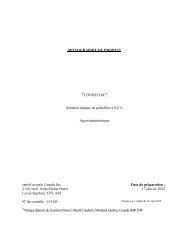Zaroxolyn (metolazone) - Sanofi Canada
Zaroxolyn (metolazone) - Sanofi Canada
Zaroxolyn (metolazone) - Sanofi Canada
Create successful ePaper yourself
Turn your PDF publications into a flip-book with our unique Google optimized e-Paper software.
Hypokalemia may occur, with consequent weakness, cramps, and cardiac arrhythmias.Hypokalemia is a particular hazard in digitalized patients or those who have had or have aventricular arrhythmia; dangerous or fatal arrhythmias may be precipitated. Serum potassiumshould be determined at regular intervals, and dose reduction, potassium supplementation oraddition of a potassium sparing diuretic instituted if indicated. Hypokalemia is dose related. (SeePRECAUTIONS).Azotemia and hyperuricemia may be noted or precipitated during the administration ofZAROXOLYN (<strong>metolazone</strong>). Infrequently, gouty attacks have been reported in persons with ahistory of gout. If azotemia and oliguria worsen during treatment of patients with severe renaldisease, <strong>metolazone</strong> should be discontinued.Unusually large or prolonged losses of fluid and electrolytes may result when <strong>metolazone</strong> isadministered concomitantly to patients receiving furosemide.Particular care must be taken, especially during initial therapy, when <strong>metolazone</strong> is used withother antihypertensive drugs of a different class to avoid excessive reduction in blood pressure.(See PRECAUTIONS, Drug Interactions).PRECAUTIONSAll patients receiving <strong>metolazone</strong> should have serum electrolytes measured at appropriateintervals and be observed for clinical signs of fluid and/or electrolyte imbalance; namely,hyponatremia, hypochloremic alkalosis, and hypokalemia. Serum and urine electrolytedeterminations are particularly important when the patient is vomiting excessively, has severediarrhea, or is receiving parenteral fluids.The risk of hypokalemia is increased when larger doses are used; when diuresis is rapid; whensevere liver disease is present; when corticosteroids are given concomitantly; when oral intake ofpotassium is inadequate or when excess potassium is being lost extrarenally; such as withvomiting or diarrhea.Hyponatremia may occur at any time during long term therapy and, on rare occasions, may belife threatening (See WARNINGS).Warning signs of electrolyte imbalance irrespective of cause are: dryness of mouth; thirst;weakness; lethargy; drowsiness; restlessness; muscle pains or cramps; muscular fatigue;hypotension; oliguria; tachycardia; and gastrointestinal disturbances such as nausea andvomiting.4
















